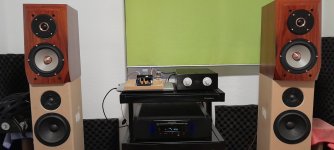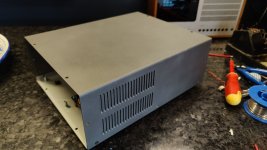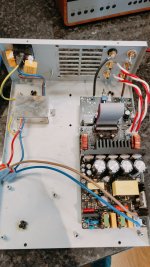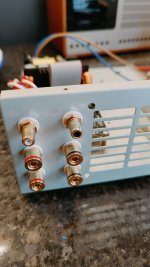Eric, really thanks for this FFA002V2 unit, I recive it today, very good packaging, sounds really good, more silent than the FFA001.
Very difficult to compare sonically, for sure the 300w model sems has more muscle But sounds really good too. As I said, I use a tube preamp to get a little warm sound and really good to my wood ears.
I'm listening now Schindler list near 23:25 in my small room and I can't ear any noise With the speakers at 1.5 meter to me. The amplifier is not in a box, is put where you can see in the picture....
Do it need some time working before give the best sound?
Thanks again !!
Very difficult to compare sonically, for sure the 300w model sems has more muscle But sounds really good too. As I said, I use a tube preamp to get a little warm sound and really good to my wood ears.
I'm listening now Schindler list near 23:25 in my small room and I can't ear any noise With the speakers at 1.5 meter to me. The amplifier is not in a box, is put where you can see in the picture....
Do it need some time working before give the best sound?
Thanks again !!
Attachments
Took delivery of the FF001_V3 recently. Very good service and quick shipping from Eric. First shipment seemed to go awry and Eric soon sent another without me even contacting him.
Are these LEDs what we would expect normal use case.
View attachment 1313190
View attachment 1313191
And could it be verified which pads to pick up if wiring signal straight to the I/O buffer board and not using the RCAs. I tried to buzz them out with a continuity test but I confused myself . Not hard admittedly but this isn't complicated and so I wasn't sure if something beyond me is in this design as all pins of the RCA seemed to beep to these round pads.
View attachment 1313192
Hi, James
Please refer to the below schematic for the RCA input. This RCA jack has an internal switch to short the signal to ground when no input plug-in.
If you want external input to wire in this board for test, you can de-solder the RCA jack and have a try 😊
Have a nice weekend~
Thanks,
Eric
Thanks for the update and glad to know you're enjoying the sound of this module.Eric, really thanks for this FFA002V2 unit, I recive it today, very good packaging, sounds really good, more silent than the FFA001.
Very difficult to compare sonically, for sure the 300w model sems has more muscle But sounds really good too. As I said, I use a tube preamp to get a little warm sound and really good to my wood ears.
I'm listening now Schindler list near 23:25 in my small room and I can't ear any noise With the speakers at 1.5 meter to me. The amplifier is not in a box, is put where you can see in the picture....
Do it need some time working before give the best sound?
Thanks again !!
IMO, I don't think it takes time working before for better output from this module😊, you can try it and share us your experience. tks
Thanks,
Eric
Thanks Eric yes I re read all the thread and I saw it mentioned about the plug shorting to ground, that's why I got a buzz between signal input and GND. Makes sense now!.
So I'm about to give it the first test. In a chassis that I need to arrange a front panel and power switch. It has a provision for a fan mounting too if needed.
Looking forward to this!
So I'm about to give it the first test. In a chassis that I need to arrange a front panel and power switch. It has a provision for a fan mounting too if needed.
Looking forward to this!
Attachments
First test disappointing, one channel only and not a good sound. Then realised I'd wired one channel to the pad that connects to earth!
2 channels working nicely now, shall report back on impressions.
Should there be potential between the heatsink and the tops of the main bulk caps. ? I just felt the HS for temperature and maybe my thumb brushed the top of the caps and I got a good old tingle.!
2 channels working nicely now, shall report back on impressions.
Should there be potential between the heatsink and the tops of the main bulk caps. ? I just felt the HS for temperature and maybe my thumb brushed the top of the caps and I got a good old tingle.!
Hi, James
The heatsink(output MOSFET attached) close to the main bulk capacitor is connected to the ground, no safety concern.
PS: For safety, please refer to below pic for the generous guideline
-- Red circle: Primary side, need to pay attention to touch/measure in this area;
-- Green circle: Secondary side;
Thanks,
Eric

The heatsink(output MOSFET attached) close to the main bulk capacitor is connected to the ground, no safety concern.
PS: For safety, please refer to below pic for the generous guideline
-- Red circle: Primary side, need to pay attention to touch/measure in this area;
-- Green circle: Secondary side;
Thanks,
Eric
The 8-ch amp I posted pics of earlier in this thread produced a loud humming/buzzing noise (through the speakers) when connected to an active 3-way Linkwitz Orion system.
Source material is from JRiver on a Windows 10 PC that's ~8 yrs old. Coax digital from its native Realtek audio chip feeds a miniDSP OpenDRC-DA8 8-ch DSP crossover. Analog outputs from the DA8 feeds the amp. I replicate the DA8 settings for one woofer into another channel so that each speaker's dual woofers are driven by a separate channel.

The buzzing seems to be isolated to one particular FFA001V3 module, the one closest to the AC input socket. The ground from the 3-terminal AC socket had been connected to a mounting screw on that amp module input board. Turning that module on standby eliminated the hum.
I disconnected the AC ground wire altogether, and the hum disappeared with all amp modules running.
I'm OK to run the amp this way with ground from AC not connected to the chassis, but I am curious about the reason for the hum.
Does this mean there's a ground loop due to one or more of the line outputs from the DA8 and/or the digital coax feed from the PC sharing common ground?
Why would it affect only one amp module?
Source material is from JRiver on a Windows 10 PC that's ~8 yrs old. Coax digital from its native Realtek audio chip feeds a miniDSP OpenDRC-DA8 8-ch DSP crossover. Analog outputs from the DA8 feeds the amp. I replicate the DA8 settings for one woofer into another channel so that each speaker's dual woofers are driven by a separate channel.
The buzzing seems to be isolated to one particular FFA001V3 module, the one closest to the AC input socket. The ground from the 3-terminal AC socket had been connected to a mounting screw on that amp module input board. Turning that module on standby eliminated the hum.
I disconnected the AC ground wire altogether, and the hum disappeared with all amp modules running.
I'm OK to run the amp this way with ground from AC not connected to the chassis, but I am curious about the reason for the hum.
Does this mean there's a ground loop due to one or more of the line outputs from the DA8 and/or the digital coax feed from the PC sharing common ground?
Why would it affect only one amp module?
The ground wire from AC socket to the input board standoff -- removing that eliminated the problem, but allowing that wire to touch any part of the chassis brought the hum back. Only in the channels of that amp modules, though.I noticed the ground wire connected to the adjacent channel, is that the root cause?
 It's hard to explain, is it possible to swap the amplifier module to identify if the hum noise follows this amp module? tks.
It's hard to explain, is it possible to swap the amplifier module to identify if the hum noise follows this amp module? tks.Eric are we OK to switch the AC mains and leave the standby switch in the on position? Seems fine.!?
Interesting idea. I have 2 more of the modules still unused. Will try soon & report back.It's hard to explain, is it possible to swap the amplifier module to identify if the hum noise follows this amp module? tks.
It's hard to explain, is it possible to swap the amplifier module to identify if the hum noise follows this amp module? tks.
So I tried several things
1. Swapped the data cable between input board & amp module. No change. Hum still happens when AC ground is touched to chassis.
2. Tried different input board. No change.
3. Tried different (previously unused) amp module. No change. In fact, hum might have got slightly louder.
4. I checked to make sure the amp board is properly grounded -- it is.
5. I also checked to make sure the input connectors on the input board is not touching the chassis through the holes on the back panel. They are not.
6. Checked AC wiring to the amp modules. All the same connections through main power switch & then through all 4 brown wires and all 4 blue wires (to AC inputs of amp modules) soldered together in 2 central bundles.
🤔😕
7. Checked continuity path between the chassis & output terminals -- all 16. Eureka! One of the 5-way binding posts for the outputs of the affected amp module was somehow making contact with the chassis! These cheapish binding posts from Amazon have insulating washers but were meant for panels 2mm or thinner. I tested a couple on this 3mm aluminum panel and they worked fine, but I did not check all of them. So 15 of them worked OK & the last one I mounted ended up somehow off center so that the threaded shaft made contact with the edge of the hole. I applied a small piece of heatshrink over that portion of the threaded shaft, and reinstalled it. No more short to chassis.
Now, the overall noise level is reduced, and there's no hum with or without the ground wire attached. (Of course, I attached it.) Silent even a foot away from the speakers. 👍
Thanks, Eric, for encouraging me to explore why. 😎🙂
CORRECTION!7. Checked continuity path between the chassis & output terminals -- all 16. Eureka! One of the 5-way binding posts for the outputs of the affected amp module was somehow making contact with the chassis! These cheapish binding posts from Amazon have insulating washers but were meant for panels 2mm or thinner. I tested a couple on this 3mm aluminum panel and they worked fine, but I did not check all of them. So 15 of them worked OK & the last one I mounted ended up somehow off center so that the threaded shaft made contact with the edge of the hole. I applied a small piece of heatshrink over that portion of the threaded shaft, and reinstalled it. No more short to chassis.
I actually had the new amp module in place when I made the correction to the binding post. Curious whether the fix would apply to the original board, I swapped them out again: The hum came back.
Powered off, then I retested the chassis to output terminals continuity with a different multimeter and found that all 16 output terminals were common to the chassis!?!? Checked the other multimeter and learned the battery was so low that the audible signal for continuity was sounding only once in a while.
Put the new amp module back. Checked output terminals to chassis continuity -- still the same, all common to chassis.
Powered up: NO HUM.
This means the first amp module is defective in some way.
I will test that module by itself later & confirm.
This was rigged up quickly in my studio w/o any case, just atop the workbench. Not a trace of hum.I will test that module by itself later & confirm.
So... something about all 4 of those modules in that case & the way I've wired it up -- afaik about as straightforward as I could -- isn't working right, at least, not for this module. Bit of a mystery, but since everything seems working fine on the 8-ch unit, I'm OK with it.
Will have to see if this module does anything odd when it gets put to work in a real system.
Meanwhile, I am still impressed at the low residual noise (just audible from 3" with a 90 dB/W tweeter in my studio) and sound quality of these amps.
Eric, regarding bridge mode in the FFA001 and FFA002. What are the output power ratings at 4R? Am I able to run a 4R driver on a bridged module, or use two bridged modules with a 4R+4R DVC driver?
It's ok to use the AC switch to power on/off the amp module.Eric are we OK to switch the AC mains and leave the standby switch in the on position? Seems fine.!?
Hi, RandyEric, regarding bridge mode in the FFA001 and FFA002. What are the output power ratings at 4R? Am I able to run a 4R driver on a bridged module, or use two bridged modules with a 4R+4R DVC driver?
These amp modules implement the current/voltage limit to keep the same output for 4R(current limit)/8R(voltage limit) in stereo mode. If you run it with bridge mode and 4R load, the output wattage is the same as the 4R load in stereo mode.
FFA002 2* 300W @ 4ohm;
2*150W@2ohm;
Bridge mode= 1*300W @4ohm
PS: If you need the 600W @4ohm in bridge mode from FFA002V2, I need to modify its current threshold .
Thanks,
Eric
Thank you for the info Eric. I will order a 1kw class driver tomorrow. I need to start working on the amp solution for this. This is the 1kw of power that I have been pestering you about, 😀 It's happening now
The driver is rated 750wrms and has 4R+4R dual voice coils. I want some amp headroom. 600w@4R mono x2 sounds very good, but 500w x2 @ 4R will do as well. Please let me know if there are any other options besides the 2x FFA002v2 bridged and adjusted modules. Also, please forward the costs for the adjusted modules. I'll start saving up for them in any case
The driver is rated 750wrms and has 4R+4R dual voice coils. I want some amp headroom. 600w@4R mono x2 sounds very good, but 500w x2 @ 4R will do as well. Please let me know if there are any other options besides the 2x FFA002v2 bridged and adjusted modules. Also, please forward the costs for the adjusted modules. I'll start saving up for them in any case
- Home
- Vendor's Bazaar
- 2x150W Amp module for sale




